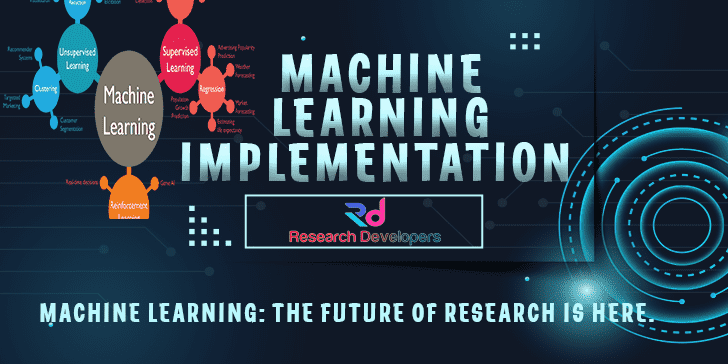Machine Learning Implementation
Where research begins: Expert guidance on topic selection.

Machine Learning Implementation
Machine Learning is defined as the ability of a machine i.e. computer to learn the system and decisio what to do for the input. This capability is programmed based in the type of input factors of the system. In simple, machine learning denotes the learning ability of the system.
Machine Learning in short as ML that operates like a machine for predicting an efficient outcome from the historical data. This ML has the ability to learn and so it is able to predict output in the system as per the current input.
Types of Machine Learning
• Supervised Learning – It processes with the labeled dataset where the training is performed and the input, output is known.
• Unsupervised Learning – The processes of classification are conducted in the unlabeled dataset where the correct output is unknown.
• Semi-Supervised Learning – In this learning, the dataset is partially labeled. It works based on supervised as well as unsupervised learning.
• Reinforcement Learning – An agent is presented for learning the environment. It operates in the absence of training dataset for decision making.
Each type of machine learning algorithm is composed of multiple algorithms in it. According to the requirement of the system, the type of ML algorithm is used. Machine Learning algorithms is used in various applications and it is popularly used for classification, text mining and dimensionality reduction. Our experts have inovative suggestions in machine learning algorithm such as,
• Decision making of Good from Bad – For instance the student marksheet could be processed and high score / low score can be predicted.
• Ranking from Top to Bottom – For instance listing of best product to the worst product, also listing of high energy consuming grid to the low energy consuming grid.
• Clustering of data – For instance the data is grouped based on the estimation of similarity in different concerns.
• Feedback Prediction – For instance designing a recommendation provisioning system based on the considered input.
Hereby few commonly used machine learning algorithms are listed below,
-Machine Learning Algorithms
• Support Vector Machine
• Naive Bayes
• Random Forest
• Linear Regression
• K-nearest Neighbour
Implementing machine learning involves several steps, which include −
Data Collection and Preparation
The first step in utilising machine learning is collecting data to train and test models. The data utilized for training a machine learning model should be relevant to the problem at hand if it is to be effective. Data cleaning and preprocessing are necessary steps after data collection to remove duplicate or missing values.
Data Exploration and Visualization
The subsequent phase involves the examination and visualisation of the data in order to acquire a deeper understanding of its organisation and detect any recurring patterns or trends. Matplotlib and seaborn are data visualisation tools that enable the creation of various visualisations, including histograms, scatter plots, and heat maps.
Feature Selection and Engineering
The selection or engineering of data aspects that are pertinent to the situation is necessary. The process of feature engineering entails the generation of novel features derived from pre-existing data, with the aim of enhancing the precision of the model.
Model Selection and Training
The selection of a suitable ML method for model training is contingent upon preliminary data preparation and the process of feature selection or engineering. To begin, it is necessary to generate a training set that may be used to train the model. The model’s accuracy is evaluated using the second set. Various machine learning techniques, such as random forests, decision trees, logistic regression, neural networks, support vector machines, and linear regression, could be employed to train the model.
Evaluation of the Model
After training the model, it must be evaluated for performance. Several metrics can be utilized for assessing the model’s performance, including recall, F1 score, precision, and accuracy. Another option for evaluating the model’s performance is to employ cross-validation techniques.
Parameter Tuning of the Model
By adjusting its hyperparameters, one can enhance the model’s performance. Hyperparameters are user-defined settings that are not learned from data. By employing methods like grid search and random search, the ideal settings for these hyperparameters can be discovered.
Deployment and Monitoring
Deploying the model to a production environment is the next step after training and tuning it. The deployment procedure does not conclude until the model is incorporated into the system or business process. It is important to keep an eye on the model to make sure it’s still performing well and fix any problems that pop up.
Each of the above steps requires different tools and techniques, and successful implementation requires a combination of technical and business skills.
Selection of an ML Development Language and Work Environment
Making decisions about the platform, IDE, and programming language is essential while creating ML apps. Several options are at your disposal. With the implementation of the AI algorithms we’ve covered thus far, most of these would easily fit your needs.
Careful understanding of the following things is required if you are creating the ML algorithm independently
• Your proficiency in a language that is supported in ML development, or the language that you choose.
• Which IDE do you utilise? How comfortable you are and how well you know the current IDEs will determine this.
• Platform for development − When it comes to development and deployment, there are a few options. These are mostly available for free. There are various circumstances where you’ll need to pay a licence fee after a specific amount of usage.
Here are some reasons why Machine learning is so essential in the modern world:
• Data processing. One of the primary reasons machine learning is so important is its ability to handle and make sense of huge data volumes. With the explosion of digital data from social media, sensors, and other sources, traditional data analysis methods have become inadequate. Algorithms based on machine learning can sift through these mountains of data, find previously unseen patterns, and deliver decisions actionable insights.
• Promoting new ideas. In many different industries, machine learning is boosting productivity and new ideas. Some instances are as follows:
• Medical treatment. Medical imaging accuracy, disease outbreak prediction, and personalised treatment regimens are all areas that benefit from algorithms.
• Income and expenditure. The three main applications of ML are fraud detection, algorithmic trading, and credit scoring.
• Applying machine learning to recommendation systems, supply chains, and customer service can yield significant benefits.
• Many other fields, including education, entertainment, and agriculture, make use of the same methods.
Machine learning is a key enabler of automation. By learning from data and improving over time, machine learning algorithms can perform previously manual tasks, freeing humans to focus on more complex and creative tasks. This not only increases efficiency but also opens up new possibilities for innovation.
Our technical team is experienced in working and has enough knowledge to innovate a research using Machine Learning. We offer all type of service including implementing and simulation. You can discuss with our technical experts and know more for understanding and work ahead in your project.
Other Services
- PHD & POST DOC Admission counselling
- Topic Section
- Review Paper Writing
- Systematic Literature Review (SLR)
- Research Paper Writing
- Synopsis Writing/Pre thesis writing
- Thesis Writing
- Data Analysis
- Questionnaire Preparation
- Developing Research Framework
- Methodology Development
- MATLAB Implementation
- Matlab Simulation
- Python Implementation
- Machine Learning Implementation
- Deep Learning Implementation
- VHDL Implementation
- Hadoop
- NS2 Implementation
- NS3 Implementation
- ArcGis Mapping & Analysis
- Spss Data Analysis
- Stata Data Analysis
- Amos Analysis
- R Programming
- E-Views Data Analysis
- Minitab Data Analysis
- Software Testing
- Ansys Implementation

